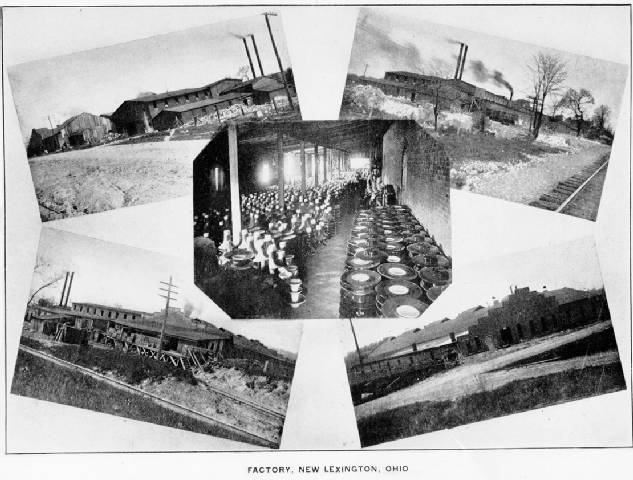
The New Lexington High Voltage
Porcelain Co.
(1903 - 1912)
Very little is known about the New Lexington High Voltage Porcelain Co. (N-L). The company was incorporated in March 1903 and located in New Lexington, OH. When the company started, construction of electrical transmission lines was nearing a peak in the boom to get all the cities in the country wired for electrical power. Transmission voltages were rising quickly, too, which required larger insulators than the unipart pintypes (including glazeweld styles) previously produced by R. Thomas & Sons, Fred M. Locke (now Locke Insulator Mfg. Co.), and Imperial Porcelain Works. Major manufacturers such as Ohio Brass (1910), Pittsburg (1908), Lapp (1916), Pinco (1921), and others had not begun to produce insulators. Thomas introduced large glazeweld styles by 1901-1902 and continued to show them in their 1904 catalog along with cemented versions. Much larger cemented multipart porcelain insulators were shown in that catalog, too, which was suitable for transmission lines of the times that carried 40,000 to 60,000 volts. Locke introduced similar large glazeweld styles in their 1904 catalog as well as several sizes of cemented multiparts up to 4-part styles for 60,000 volts. Additional information about these companies and the insulators they produced can be found in my new book, Multipart Porcelain Insulators.
1903 was a great year to enter the insulator business since there were few competitors and the demand for porcelain insulators was greater than the supply. Glass insulators were not considered suitable for high voltage transmission service even after the success of the Hemingray Muncies in Montana. Porcelain was the only material suitable for high voltage service since it possessed strength and durability. To produce good porcelain, you needed a supply of fuel such as natural gas. New Lexington, OH had a reliable supply of fuel gas, known deposits of clay, and expertise could be easily obtained from nearby East Liverpool, OH, which was the center of electrical porcelain manufacture in the country. It was a perfect location and a perfect time to start an insulator manufacturing business.
N-L essentially copied basic styles made by Locke and Thomas. They sold their insulators through other companies or jobbers such as Ohio Brass (in 1907), Johns-Manville, C. S. Knowles (in 1907), and J. H. Parker & Sons. They also marketed insulators directly through their own catalogs. No N-L catalogs are known to have survived. In the early 1970’s, Jack Tod made a rather poor copy of 16 pages from a 1908 N-L catalog he found at Ohio Brass. Unfortunately, Jack was only interested in unipart pintypes and did not copy the pages that showed multipart styles and other insulators. That and other catalogs he copied at Ohio Brass have since disappeared. We do not have an earlier copy of the J. H. Parker catalog, but it is obvious from the circa 1917 catalog (in Brent Mills book) that they were carrying unique N-L styles such as: M-2000, M-2142, M-2820, M-3055, M-3281, M-3400, M-3715, and M-3960. Naturally, N-L was out of business in 1912 long before the circa 1917 Parker catalog. The following insulators have been attributed to N-L by either markings or characteristics:
Specimens with New Lexington marking (number of specimens known in parentheses): U-552 (1), U-746 (9), U-954 (1), U-966A (5), M-2140 (1), M-2260B (1), M-2440 (2), M-2637 (3), M-2841 (2), M-3022 (2), M-3890 (broken crowns only). Note that U-552 was reported about 20 years ago and the location of that specimen is unknown.
Multipart specimens with Johns-Manville marking (number of specimens known in parentheses): M-2140 (3), M-2635 (1), M-2636 (2), M-3150A (2), and M-3222 (1). Unipart specimens of U-241A with Johns-Manville were made by Pittsburg High Voltage Insulator Co. We have not determined which company made U-746 specimens with J-M marking.
Note: M-numbers can be found in my new book, Multipart Porcelain Insulators, and U-numbers can be found in Jack Tod's book, Porcelain Insulator Guide Book.
Location where N-L marked specimens have been found are sketchy. It has been reported that Dave Ramp found all the U-966A’s around 1972-75 at old copper/iron mines in upper Michigan. All of the marked U-746’s were found in the Salt Lake City area in the late 1970’s. One marked M-2260B and several unmarked specimens were found in the northwest. The crowns of M-3890 were found in the Niagara area.

The above page was taken from the 1907
C. S. Knowles catalog.
It is odd that the 1907 C. S. Knowles catalog referred to N-L insulators by the tradename “Crown”. While not stating New Lexington High Voltage Porcelain Co. by name, the catalog indicated the porcelain factory was located in New Lexington, OH. The illustrations of all of the “Crown” unipart styles shown in that catalog are identical to that shown in their 1902 catalog, which described them with the “Imperial” tradename accompanied by an illustration of the identical crown logo used by Imperial Porcelain Works on every insulator they made after July 1, 1897, except for a few specimens of two styles made in 1903. The C. S. Knowles “Imperial” styles were definitely made by Imperial Porcelain Works as the factory was indicated to be in Trenton, NJ at that time.
N-L probably fell to competition after two other large companies started producing insulators: Pittsburg High Voltage Insulator Co. in 1908 and Ohio Brass in 1910 (purchase of Akron HP factory). By 1912, N-L was in serious financial difficulties. Payments on two mortgages were behind. Various transfers of ownership occurred until June 19, 1918 when General Porcelain Co. purchased the property for $7,750. A large stock of molds, insulators, and soup bowls and various quantities of clay and other materials were itemized in the sale. General Porcelain stripped the plant and sold it on July 25, 1918 with the understanding that it would not be used to make porcelain insulators or doorknobs for a period of five years. The defunct factory was known as Consumers Insulator Co. between Oct. 5, 1912 and Nov. 15, 1914. One postcard has been found with an illustration of the factory using this name (see front cover of this pamphlet). Below are copies of the only two other postcards that have been reported. All three postcards are from the collection of James Murphy.
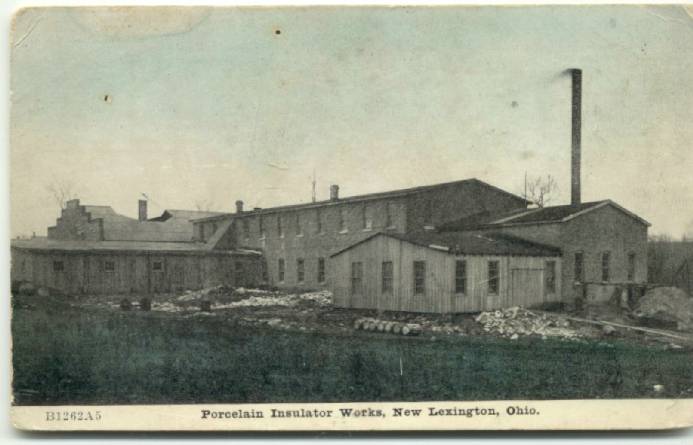
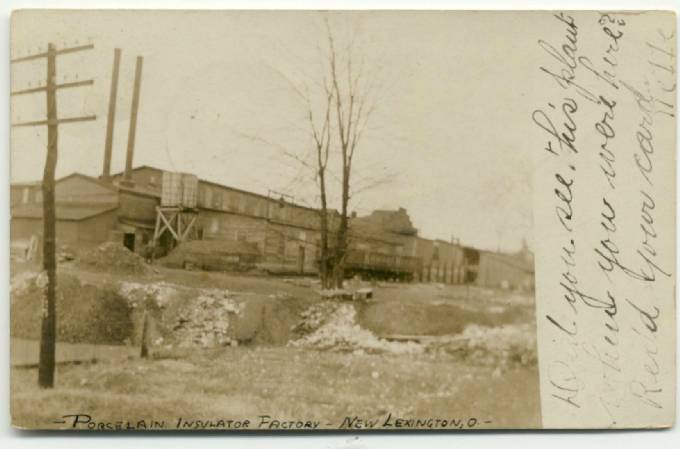
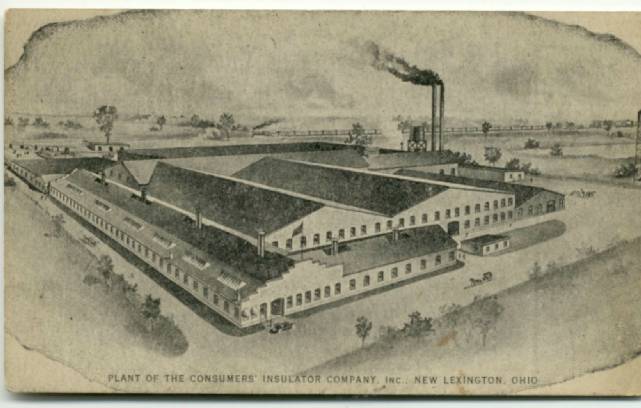
There is a letter in Jack Tod’s files from 1972 written by Murra Fowler. He said this about the N-L factory: “Ground was broken in June of 1902, and building, kilns, etc. completed in August 1903. Production started in September. As a young boy, I carried moulds to and from one of the presses ten hours a day, six days a week, for the large sum of 12-1/2 cents per hour. Their slogan was “High potential insulators for the transmission of great power.” Local businessmen owned all stock in the plant. They hired “Bunker” Brown as Supt. and “Capt.” Lowery as General Manager. These men came from East Liverpool, O. They were experienced pottery men. It furnished more insulators to the Pacific Coast power plants than all its competitors.” The N-L factory also made porcelain tableware. Mr. Fowler reported a man who had a small meat plate and a cup and saucer.
Markings:
Only 25 unipart and multipart insulators have been reported with the incuse N-L marking:
NEW LEXINGTON, O.
Most of the insulators that bear this marking are U-746. The marking is very rare indeed even on U-746 with only nine confirmed specimens. Only ten multipart insulators have been reported with this marking comprising six different styles. Four of the six multipart styles are shown in my display with the N-L marking along with three of the four unipart styles. All multipart porcelain insulators with the incuse marking, JOHNS-MANVILLE, were made by N-L. Unipart insulators with this marking were made by Pittsburg with the possible exception of U-746.
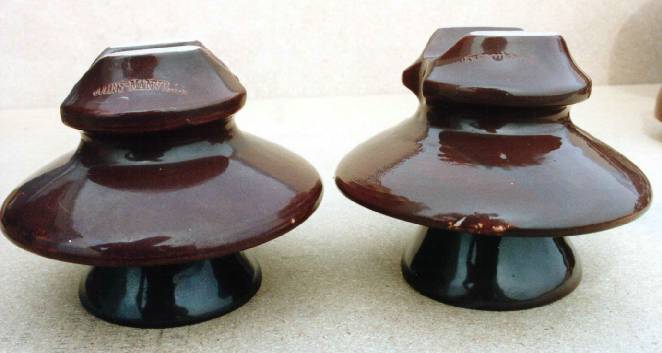
Both M-2140 insulators shown above with incuse marking JOHNS-MANVILLE are in the
collection of Bill Rohde.
New Lexington: Page 2